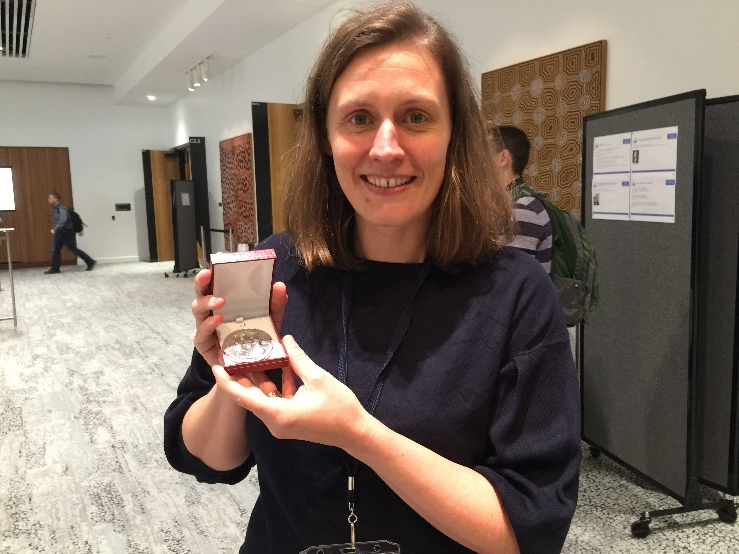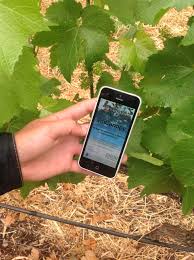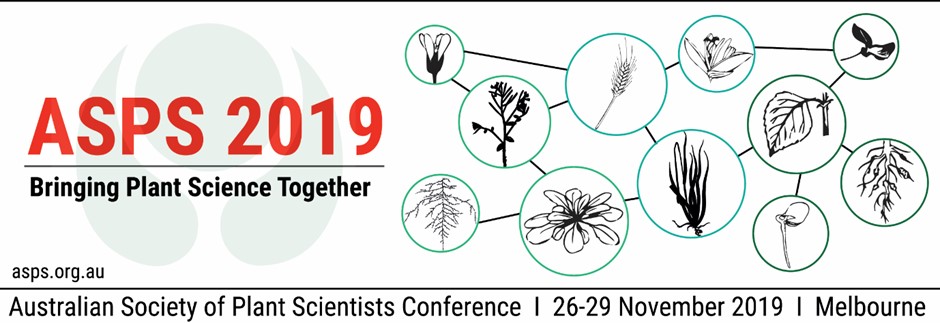Now we are past the middle of the year and to think, 50 years ago today astronauts were walking on the moon. I hope over the next few weeks you will marvel at the stars and this may inspire you in your current pursuits.

In our July issue, we recognise two Award Recipients, Dr Caitlin Byrt and Associate Professor Sigfredo Fuentes. Caitlin Byrt is a bright emerging researcher awarded the Peter Goldacre Award in 2018. I always remember from seeing her talk the multitude of collaborators she acknowledged. It demonstrated a vibrant global community supporting her to reach for the stars and tackle the grand challenge of maximising plant yields.
In Melbourne this year, we can look forward to hearing from the 2019 award recipient, Simon Williams from the Australian National University.
Peter Goldacre was a foundation member of ASPP, and an enthusiastic supporter of the Society from its inception. With a Science Degree from the University of Sydney, majoring in chemistry and biochemistry, he took up a research position at what was then the CSIR Division of Plant Industry in Canberra in 1947. Peter was an enthusiastic researcher who was held in great respect by his peers. His tragic death in 1960 from stomach cancer at age 34 shocked and saddened all his friends and colleagues. The Goldacre Medal was subsequently established as a lasting tribute to his contributions in plant physiology, and as an encouragement to young researchers. Functional Plant Biology now sponsors the Goldacre Award. The Award is made on the merit of original research in one area, the findings of which have been published, or accepted for publication, in the three years preceding the year of the Award. The work should have been done within 10 years of the candidate submitting their PhD.
 The recipient of the 2018 Goldacre Award, Dr Caitlin Byrt (University of Adelaide, now Australian National University) for her work on studying membrane transporters towards enhancing crop yields.
The recipient of the 2018 Goldacre Award, Dr Caitlin Byrt (University of Adelaide, now Australian National University) for her work on studying membrane transporters towards enhancing crop yields.
ComBio 2018 Peter Goldacre Lecture Abstract
CELL MEMBRANE WATER CHANNELS WITH BUILT IN ION CHANNELS
Byrt C.S.1, 2, Qiu J.1, 2, McGaughey S.1, 2, Groszmann M. 3, 4, Bose J.1, 2 and Tyerman S.D.1, 2
1The University of Adelaide. 2ARC Centre of Excellence in Plant Energy Biology. 3 Australian National University. 4 ARC Centre of Excellence for Translational Photosynthesis
Cell function is dependent on maintenance of water and ionic homeostasis. Aquaporins are regulated by cells to achieve water homeostasis, but in addition they may also be required for ion homeostasis. Cell water permeability is determined by the water conductance and density of aquaporins present in the plasma membrane. Plants express in the order of 30 to 70 different types of aquaporins, depending on the plant species, and these include a group called PIPs that are particularly abundant in plasma membranes. PIPs generally form tetramers with each monomer capable of allowing the passage of water. There are subsets of PIP tetramers that allow passage of other solutes, and we have identified PIPs that can change between functioning as water channels and non-selective cation channels (NSCCs) when expressed in heterologous systems. In plants there are likely to be multiple types of NSCCs and previous studies have revealed that NSCCs, for which the molecular candidates are so far unidentified, can provide a pathway for nutrient transport, and also for sodium transport under salinity stress. PIPs functioning as ion channels can allow passage of sodium and potassium, and they share similar properties with previously reported NSCCs. For example, NSCC and PIP ionic conductance are sensitive to calcium, pH and cyclic nucleotides. We are testing whether PIPs can account for any of the previously observed NSCC functions in plants by studying ion transport traits in mutant and transgenic lines of Arabidopsis where the PIPs of interest are either knocked out, overexpressed or mutated to change their ion channel function. Testing whether PIPs are implicated in maintaining water and ionic homeostasis in plants is an important step towards resolving the roles of PIPs in plant tolerance to dry, saline and nutrient deficient environments.
https://onlinelibrary.wiley.com/doi/full/10.1111/pce.12832
|
The aquaporin AtPIP2;1 is an abundant plasma membrane intrinsic protein in Arabidopsis thaliana that is implicated in stomatal closure, and is highly expressed in plasma membranes of root epidermal cells. When expressed in Xenopus laevis oocytes, AtPIP2;1 increased water permeability and induced a non‐selective cation conductance mainly associated with Na +.
onlinelibrary.wiley.com
|
For: Byrt, C.S., Zhao, M., Kourghi, M., Bose, J., Henderson, S.W., Qiu, J., Gilliham, M., Schultz, C., Schwarz, M., Ramesh, S.A. and Yool, A., 2017. Non‐selective cation channel activity of aquaporin AtPIP2; 1 regulated by Ca2+ and pH. Plant, cell & environment, 40(6), pp.802-815.
Next, Associate Professor Sigfredo Fuentes is awarded the Plant Science Teaching Prize for Plant Physiology. We will look forward to hearing from him at ASPS2019 at La Trobe University from 26th-29th November.
Sigfredo Fuentes is an Associate Professor in Digital Agriculture, Food and Wine Sciences at the University of Melbourne. His previous research employment include the University of Adelaide, Univ. of Technology, Sydney; Univ. of Western Sydney (PhD) and Univ. of Talca, Chile. His repertoire ranges from climate change impacts on agriculture, development of new computational tools for plant physiology, food and wine science, new and emerging sensor technology, proximal, short- and long-range remote sensing using robots and UAVs, and the application of machine learning and artificial intelligence in these fields.
For more information visit: www.vineyardofthefuture.wordpress.com
 In the present age, students and majority of young people are heavily engaged and reliant on smart devices (smart phones and tablet PCs) as part of daily routines. It is therefore wise to take advantage of this avenue to deliver learning tools right into the hands of students. Advances in digital technologies in the form of portable smart devices and app-based sensor technologies, such as infrared thermal imaging and near infrared spectroscopy devices, have made the development and application of novel tools for teaching and learning purposes in plant physiology readily accessible. The adeptness of students to handheld technology enabled these tools to be easily implemented, with high reception, engagement and interest.
In the present age, students and majority of young people are heavily engaged and reliant on smart devices (smart phones and tablet PCs) as part of daily routines. It is therefore wise to take advantage of this avenue to deliver learning tools right into the hands of students. Advances in digital technologies in the form of portable smart devices and app-based sensor technologies, such as infrared thermal imaging and near infrared spectroscopy devices, have made the development and application of novel tools for teaching and learning purposes in plant physiology readily accessible. The adeptness of students to handheld technology enabled these tools to be easily implemented, with high reception, engagement and interest.
The recipient of the 2019 Plant Science Teaching Prize for Plant Physiology, Associate Professor Sigfredo Fuentes, University of Melbourne for application of new and emerging technologies for digital teaching and learning in plant physiology.
 UAVs and Apps
UAVs and Apps
The development of teaching and learning tools based on new and emerging technologies is a critical step to increase engagement of students in complicated physiological processes of plants, such as transpiration rate, stomatal conductance, nutrient levels and photosynthesis rate, among others, that can be assessed in real time. These tools have the potential to be delivered right into the students’ smart phones, providing individualised access and hands-on learning experience. It has been a common practice for students to show these apps to peers and family members, which have increased the engagements of their circles either through direct contact or posting results into social media.
Since 2008, Sigfredo has been actively creating and writing computer codes, programs and computer Applications (Apps) for Plant Science teaching and research. Some of these tools have been adopted commercially and by other national and international tertiary teaching & research institutions in South America (Chile and Argentina), USA, Europe (Spain, France and Italy), China and South Africa. Furthermore, most of the tools have been published in peer reviewed journals and have been used by a number of undergraduate / postgraduate students for their Bachelors, Master and PhD degrees not only in Australia but also around the world. These tools have also helpedtogenerate new ideas on the implementation of computer and sensor applications using the Internet of Things (IoT) in Plant Science and Agriculture and have been used to support lectures and practical from Plant Science, Food Science, Sensory Science, Animal Science, Engineering, Viticulture and Oenology subjects at national and international universities. Specific codes for multivariate statistical analysis have been also developed with respective manuals (teaching publications). These tools have facilitated student learning experience and research performance, resulting in high Student Experience Survey scores (Average of 4.1 from 5 for all subjects).
- Wetting Pattern Analyser (WPA©): 2D and 3D visualization of soil moisture and salinity/nutrient patterns from soil moisture/salinity sensors. Adopted commercially by Sentek Pty. Ltd. (www.sentek.com.au).
- BerryAlive: Computer code written in Matlab® to analyse fluorescence microscopy images of berries to estimate berry cell death and shrivel.
- VitiCanopy: A computer application (App) for tablet PCs and smartphones to assess canopy architecture and leaf area index for horticultural crops using cover photography and computer vision algorithms. https://www.plantransig.com/techniques/viticanopy/
- Spatial Vigour / Spectral Analyser:Analysis of spatial canopy vigour and multispectral analysis using computer vision algorithms at the plant-by-plant scale from UAV or satellite imagery,
- IR-CanopyAnalyser: High throughput automated analysis of infrared thermal images from canopies to obtain canopy conductance indices and crop water stress indices.
- PCA-Cov: Principal component and covariance analysis codes for graphical and numerical outputs written in Matlab® with associated manuals. These tools have helped to improve Student Experience Survey scores from courses associated with this type of analysis.
- Inspector-PAW: Computer App developed for Android OS to automatically acquire accelerometer and GPS data from a smartphone device located in backpacks of trained dogs to record data from identified stimuli such as weeds, pest and diseases detection in orchards. Data can be later on mapped using GIS and modelled using machine learning algorithms. Publication under preparation.
- AppleZize App: Computer App developed to identify diameter of apple fruits and extraction of fruit temperature from digital and infrared images in the field. Information acquired is then plugged in developed algorithms using machine learning techniques to assess final fruit size at harvest and sunburn risk. Publications in preparation.
- LeafDetector: Matlab code developed to extract morpho-colorimetric data from scanned/photographed leaves. Data automatically extracted includes more than 15 parameters, such as diameter, perimeter, fractal analysis of the edges, colour in the CieLAB and RGB codes. Machine learning algorithms can be developed to recognise cultivars automatically from leaf images. Applied already to grapevine cultivars and Chinese medicinal plants.
- Machine learning batch analysis:code developed to test machine learning algorithms using plant physiology data as inputs and targets such as: smoke contamination in leaves and berries; transpiration rate (day and night); plant water status, among others. This code tests around 60 ML algorithms, such as Artificial Neural Networks, Decision trees, Support vector machines, among others.
Some Relevant Publications and Tools Employed
- Xiaoyi Wang, Roberta De Bei, Sigfredo Fuentes, Cassandra Collins: Influence of Canopy Management Practices on Reproductive Performance of Semillon and Shiraz Grapevines in a Hot Climate. American Journal of Enology and Viticulture 04/2019; (Tools: 3).
- J. Tongson, S. Fuentes, M. Carrasco-Benavides, M. Mora: Canopy architecture assessment of cherry trees by cover photography based on variable light extinction coefficient modelled using artificial neural networks. Acta horticulturae 02/2019;, DOI:10.17660/ActaHortic.2019.1235.24. (Tools: 3).
- De Bei, S. Fuentes, M.G. Wirthensohn, D. Cozzolino, S.D. Tyerman: Feasibility study on the use of Near Infrared spectroscopy to measure water status of almond trees. Acta horticulturae 10/2018;, DOI:10.17660/ActaHortic.2018.1219.14. (Tools: 4).
- Xue Jinru, Sigfredo Fuentes, Carlos Poblete-Echeverría, Claudia Gonzalez Viejo, Eden Tongson, Baofeng Su (2019): Automated Chinese medicinal plants classification based on machine learning using leaf morpho-colorimetry, fractal dimension and visible / near infrared spectroscopy. International Journal of Agricultural and Biological Engineering (Accepted); (Tools: 9, 10).
- Xue Jinru, Yeman Fan, Baofeng Su, Sigfredo Fuentes(2018): Assessment of Canopy Vigor Information from Kiwifruit Plants Based on a Digital Surface Model from Unmanned Aerial Vehicle Imagery. International Journal of Agricultural and Biological Engineering;, DOI:10.25165/j.ijabe.20191201.4634. (Tools: 4).
- Zuniga M., Ortega-Farias S., Fuentes S., Riveros-Burgos C., Poblete-Echeverria C. 2018. Effects of three irrigation strategies on gas exchange relationships, plant water status, yield components and water productivity on grafted Carmenere grapevines. Frontiers in Agriculture. 9: 992. (Tools: 5, 6).
- Fuentes S., Hernández-Montes E., Escalona JM., Bota J. Gonzalez Viejo C., Poblete-Echeverría C., Tongson E., Medrano H. 2018. Automated grapevine cultivar classification and water stress assessment based on machine learning using leaf morpho-colorimetry, fractal dimension and near-infrared spectroscopy. Computers and Electronics in Agriculture. 151: 311-318. (Tools: 9, 10).
- Sajitha Biju, Sigfredo Fuentes, Dorin Gupta. The use of infrared thermal imaging as a non-destructive screening tool for identifying drought-tolerant lentil genotypes. Plant Physiology and Biochemistry. 127., DOI:10.1016/j.plaphy.2018.03.005. (Tools: 5, 6).
- Maria Romero, Yuchen Luo, Baofeng Su, Sigfredo Fuentes. Vineyard water status estimation using multispectral imagery from an UAV platform and machine learning algorithms for irrigation scheduling management. Computers and Electronics in Agriculture. 147., DOI:10.1016/j.compag.2018.02.013. (Tools: 4, 10).
- Suyoung Park, Dongryeol Ryu, Sigfredo Fuentes, Hoam Chung, Esther Hernández-Montes, Mark O’Connell: Adaptive Estimation of Crop Water Stress in Nectarine and Peach Orchards Using High-Resolution Imagery from an Unmanned Aerial Vehicle (UAV). Remote Sensing 08/2017; 9(828)., DOI:10.3390/rs9080828. (Tools: 4, 5).
- Baofeng, S., Jinru, X., Chunyu, X., Yulin, F., Yuyang, S., & Fuentes, S.(2016). Digital surface model applied to unmanned aerial vehicle based photogrammetry to assess potential biotic or abiotic effects on grapevine canopies. International Journal of Agricultural and Biological Engineering, 9(6), 119. (Tools: 4).
- Mora, M., Avila, F., Carrasco-Benavides, M., Maldonado, G., Olguín-Cáceres, J., & Fuentes, S.(2016). Automated computation of leaf area index from fruit trees using improved image processing algorithms applied to canopy cover digital photograpies. Computers and Electronics in Agriculture, 123, 195-202. (Tools: 3).
- De Bei, R., Fuentes, S., Gilliham, M., Tyerman, S., Edwards, E., Bianchini, N., . . . Collins, C. (2016). VitiCanopy: A free computer App to estimate canopy vigor and porosity for grapevine. Sensors, 16(4), 585. (Tools: 3).
- Carrasco-Benavides, M., Mora, M., Maldonado, G., Olguín-Cáceres, J., von Bennewitz, E., Ortega-Farías, S., John Gajardo and Fuentes, S.(2016). Assessment of an automated digital method to estimate leaf area index (LAI) in cherry trees. New Zealand Journal of Crop and Horticultural Science, 44(4), 247-261. (Tools: 3).
- Park, S., Nolan, A., Ryu, D., Fuentes, S., Hernandez, E., Chung, H., & O’Connell, M. (2015) Estimation of crop water stress in a nectarine orchard using high-resolution imagery from unmanned aerial vehicle (UAV). Paper presented at the MODSIM2015, 21st International Congress on Modelling and Simulation. (Tools: 5).
- Nolan, A., Park, S., Fuentes, S., Ryu, D., & Chung, H. (2015). Automated detection and segmentation of vine rows using high resolution UAS imagery in a commercial vineyard.Paper presented at the MODSIM2015, 21st International Congress on Modelling and Simulation. (Tools: 5).
- Poblete-Echeverría, C., Fuentes, S., Ortega-Farias, S., Gonzalez-Talice, J., & Yuri, J. A. (2015). Digital cover photography for estimating leaf area index (LAI) in apple trees using a variable light extinction coefficient. Sensors, 15(2), 2860-2872. (Tools 3).
- Fuentes, S., Poblete‐Echeverría, C., Ortega‐Farias, S., Tyerman, S., & De Bei, R. (2014). Automated estimation of leaf area index from grapevine canopies using cover photography, video and computational analysis methods. Australian Journal of Grape and Wine Research, 20(3), 465-473. (Tools: 3).
- Bonada, M., Sadras, V., Moran, M., & Fuentes, S.(2013). Elevated temperature and water stress accelerate mesocarp cell death and shrivelling, and decouple sensory traits in Shiraz berries. Irrigation Science, 31(6), 1317-1331. (Tools: 2).
- Fuentes, S., Mahadevan, M., Bonada, M., Skewes, M., & Cox, J. (2013). Night-time sap flow is parabolically linked to midday water potential for field-grown almond trees. Irrigation Science, 31(6), 1265-1276. (Tools: 2).
- Bonada, M., Sadras, V. O., & Fuentes, S. (2013). Effect of elevated temperature on the onset and rate of mesocarp cell death in berries of Shiraz and Chardonnay and its relationship with berry shrivel. Australian Journal of Grape and Wine Research, 19(1), 87-94. (Tools: 2).
- Conn, S. J., Hocking, B., Dayod, M., Xu, B., Athman, A., Henderson, S., . . . Fuentes, S.(2013). Protocol: optimising hydroponic growth systems for nutritional and physiological analysis of Arabidopsis thaliana and other plants. Plant Methods, 9(1), 4. (Tools: 9).
- Fuentes, S., De Bei, R., Pech, J., & Tyerman, S. (2012). Computational water stress indices obtained from thermal image analysis of grapevine canopies. Irrigation Science, 30(6), 523-536. (Tools: 5).
- Fuentes, S., Sullivan, W., Tilbrook, J., & Tyerman, S. (2010). A novel analysis of grapevine berry tissue demonstrates a variety‐dependent correlation between tissue vitality and berry shrivel. Australian Journal of Grape and Wine Research, 16(2), 327-336. (Tools: 2).


Lastly, register for our meeting. You have until Wednesday July 31st to register and submit abstracts for talks and posters. There will not be a later date for posters at this stage. It’s T-minus 10 days. Let the countdown begin…….

